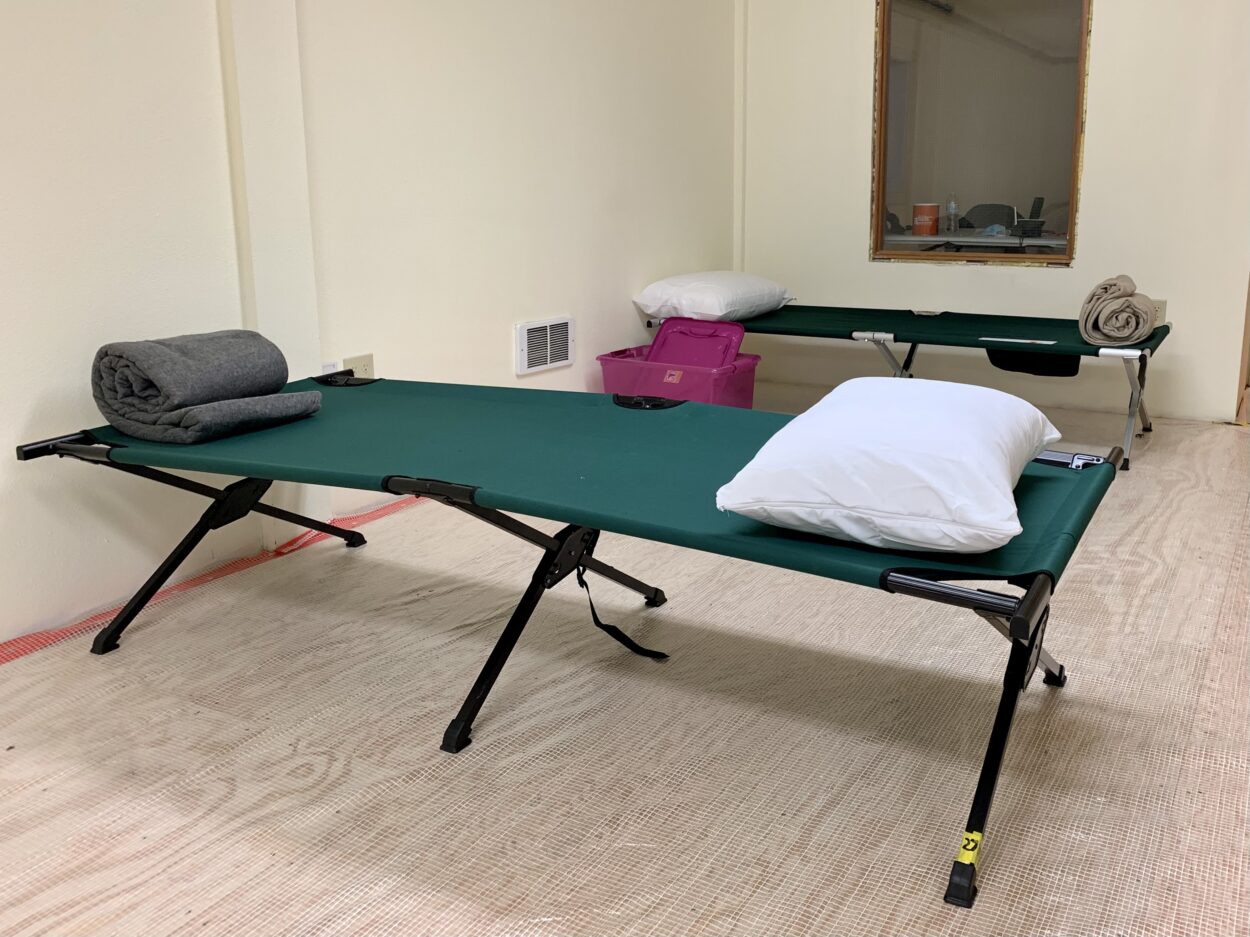
A cot is topped with a pillow and a blanket in the basement of First City Homeless Services’ Overnight Warming Center. (Eric Stone/KRBD)
Homeless people in Ketchikan now have a new place to sleep during the colder winter months. Ketchikan’s Overnight Warming Center is open for its fourth season — in a new, upgraded home.
It’s an unassuming A-frame building across from Ketchikan’s American Legion post.
At one point, it was a warehouse for the city’s water department. Then a youth-focused nonprofit took it over to use as a community center. And now, it’s providing dry, warm beds for Ketchikan’s homeless population.
Russell is one of the folks that spends the night in that building. To protect his privacy, we agreed to not use his full name.
“I came up here to see family and, basically, possibly, say goodbyes,” he said in an interview at the shelter last week.
He said doctors told him he had a 40% chance of living beyond a year after a heart valve infection. That was two years ago.
But this fall, he said he lost his home after a dispute with his roommate.
“I got kicked out and the police asked me, ‘You got anywhere to go?’ It’s snowing outside. I was like, ‘No, I don’t,’ — they couldn’t do anything. They couldn’t help me out at all. I went and crawled underneath the Tongass [Trading Company] parking lot and tried to roll up in some like wet blankets to try to stay warm,” he said.
He said he managed to keep warm that night. But it’s a little easier now that Ketchikan’s Overnight Warming Center has reopened.
Since 2017, First City Homeless Services has operated a warming shelter to prevent people without homes from dying of exposure during Ketchikan’s long, dark, wet winter.

The exterior of the building that is now the Overnight Warming Center is shown in September. It’s located at 632 Park Avenue. (Eric Stone/KRBD)
Juneau operates a similar facility on nights when temps dip below freezing. Ketchikan’s is open every night during the winter.
First City Homeless Services Program Supervisor Donita O’Dell said exposure is a big problem — and not just in colder months.
“In July and August, we lost three members of the homeless community,” she said. “One went to sleep and just never woke up on a night in July — particularly stormy night, windy, very wet. And as far as we know, that was due to exposure. We lost one gentleman in the [Tongass] Narrows, and one gentleman to an overdose.”
But this year, that overnight shelter didn’t open as it usually would. On October 15, the basement of First United Methodist Church remained sealed off. O’Dell said it’s only through sheer luck she hasn’t heard of any reported deaths. But she said she doesn’t blame the church: she said poor ventilation in the basement made it a non-starter.
“Once we were dealing with COVID, there was just no way that we could operate there,” O’Dell said.
A church basement isn’t prime for social distancing, either.
“So most of them were within two feet of each other sleeping on the just vinyl over top of the concrete floor,” O’Dell said. “No blankets, no pillows, no bedding of any kind allowed in that shelter, because there’s no sprinkler system, no fire suppression system or fire alarm system other than just smoke detectors.”
In April, the shelter relocated to the borough-owned rec center. But about a month later, it closed as the rec center prepared to reopen to the public. That left them without any good options this fall.
Then the city of Ketchikan stepped in. The City Council voted to repossess the warehouse they’d given to a youth organization. It was supposed to be a community center for at-risk kids, but unfinished renovations and unpaid bills meant the youth facility was rarely open.
Renovations to complete the shelter are still underway. But two dozen cots now occupy the main floor and the basement.
“It’s not all finished. We’re still waiting on flooring to get put in and trim and stuff like that,” she said. “But we’re chipping away at the punch list getting really close to being finished.”
O’Dell said they’re working on outfitting two more rooms specifically for people who have to quarantine, or for people who need bed rest after spending time in the hospital.
“When we have participants who are hospitalized, and then they’re discharged from the hospital, we see a really high rate of them getting returned to the hospital,” she said, “because they don’t have a place to recover from surgeries or more serious illnesses.”
And down the road, O’Dell said First City Homeless Services and the city plan to build an addition to the building to serve meals. Much of the budget for the renovations comes from federal grants.
Russell, the patron, said the new shelter is a big help. But he said there’s more that could be done to support homeless people in Ketchikan. He’s been working odd jobs — busting rocks, chopping wood — but he’s a tradesman. He’s hung drywall. He’d like to get his general contractor’s license and go to school to be an electrician.
“What would be really helpful is like a temporary work agency,” he said.
He said one-off odd jobs mean it’s tough to make ends meet. Another person at the shelter suggested another idea: a locker to store their belongings, like tools.
There are no hard numbers on the size of Ketchikan’s homeless population. A survey of the city’s shelters on one night this past January counted 53 people. But O’Dell said there are at least 80, after taking into account people forced to live in cars or on boats or couch-surf with friends and family.





